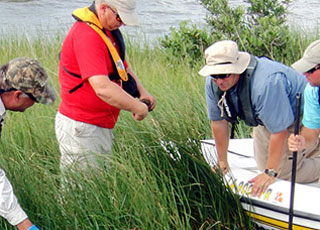
Approximately $2.7M in projects have been awarded by the NOAA RESTORE Act Science Program to synthesize current scientific understanding and management needs within three priority areas: modeling, monitoring, and ecosystem and health indicators. The NOAA RESTORE Act Science Program was established to support the science and coordination necessary for better understanding and management of the Gulf of Mexico ecosystem and its resources. In FY15, the program made significant strides in support of that goal, including: hiring a Director and Associate Director, finalizing the program's science plan, and completing the program's initial competition for funds. Outputs from these investments will inform the future direction of the NOAA RESTORE Act Science Program as well as the other science and restoration initiatives in the region.
The science plan includes ten, long-term research priorities that will guide how the program invests its funds. It also explains how prior assessments for the Gulf of Mexico region, stakeholder input, and public comments were incorporated into the final plan. The NOAA RESTORE Act Science Program will work closely with the research and resource management communities to address the priorities outlined in the plan.
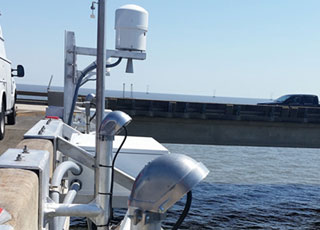
The Center for Operational Oceanographic Products and Services (CO-OPS) and the National Weather Service, partnered to fill a much needed gap in observations of Lake Pontchartrain that will help New Orleans to be more resilient in the face of severe storms. CO-OPS installed a water level station that uses new microwave water level measurement technology and includes a meteorological station and that will help local, state, and federal emergency managers plan for and respond to flooding. This station will provide continuous real time measurements before, during, and after a storm event. The station is built to withstand a category 4 hurricane and will provide real time data for accurate lake modeling, storm surge predictions, and emergency planning and evacuation orders.
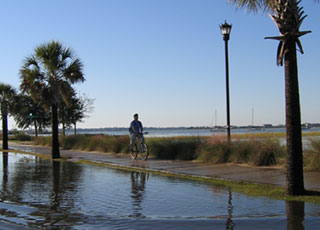
Coastal communities can start preparing now for increased flooding caused by sea level rise and storms with new coastal intelligence provided this year through the Center for Operational Oceanographic Products and Services (CO-OPS). CO-OPS issued an update to its 2015 report, Sea Level Rise and Nuisance Flood Frequency Changes around the United Statesthat examines the current state of climate-driven "nuisance flooding" and provides an outlook for 2015. This information helps coastal communities become more resilient by allowing them to assess flooding risk and develop ways to mitigate and adapt to the effects of sea level rise. CO-OPS, in partnership with National Geodetic Survey, U.S. Integrated Ocean Observing System Program, Office of Coast Survey, and Office for Coastal Management also expanded an inundation benchmark project to Norfolk, VA and Beaufort, NC that will allow weather forecasters and emergency management officials to use well-known landmarks, such as statues, as a way to better visualize and communicate water levels and impacts during floods. CO-OPS maintains the nation's only water level observation system and is the authoritative source for sea level data. As of this year, more than 140 of the existing 210 water level gauges have operated for more than 30 years, providing consistent high quality records of sea level change for the nation through sea level trends and statistics put out through CO-OPS Sea Level Trendswebsite.
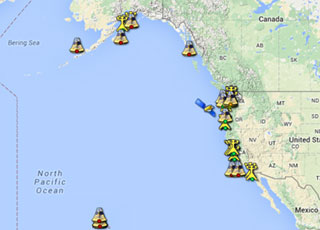
The IOOS Pacific Region Ocean Acidification Portal was launched in October 2014. Funded through a grant award from U. S. IOOS' Ocean Technology Transfer Project in collaboration with NOAA's Ocean Acidification (OA) Program, this portal provides shellfish growers, researchers and others interested in ocean acidification with access to comprehensive, real-time ocean acidification data from Alaska, Hawaii, Oregon, California and Washington State.
This grant award also expanded monitoring of ocean acidification in the Pacific Ocean region. Alaska, Pacific Northwest, Central and Northern California, and Southern California IOOS regions deployed ocean acidification monitoring sensors, developed by Dr. Burke Hales at Oregon State University, at five oyster farms and hatcheries in California, Oregon, Washington, and Alaska. Data from monitoring equipment enables shellfish growers to assess how the chemical make-up of the water will affect shellfish productivity and adapt their aquaculture practices to minimize impacts from ocean acidification to their operations.

Using data from the U.S. IOOS Program, the Office of Coast Survey added New York Harbor as the third site for the High Frequency (HF) Radar web product, joining lower Chesapeake Bay and San Francisco Bay. HF Radar provides near-real time surface current observations and tidal current predictions in estuarine and coastal locations.The product offers broad spatial coverage of surface currents in areas vital for marine navigation. The HF Radar web product also supports NOAA's Physical Oceanographic Real-Time System (PORTS®), a system that provides real-time water level, currents and meteorological observations for safe navigation.
IOOS also published the sixth and seventh Quality Assurance of Real Time Ocean Data (QARTOD) manuals addressing standard quality assurance practices for oceanographic data variables. One of the manuals published this year provides guidance to the U.S. IOOS Regional Associations and the wind community at large for the real-time quality control of wind speed, direction, and gust measurements using a standard process. The other provides guidance to the U.S. IOOS Regional Associations and the water-quality community at large for the real-time quality control of ocean optics measurements using an agreed-upon, documented, and implemented standard process. A third manual, providing guidance on real-time quality control of dissolved oxygen measurements was also updated.

The U.S. IOOS Program and The Office of Naval Research (ONR) working with Stanford University, University of California (UC) and the NOAA Southwest Fisheries Science Center Environmental Research Division launched the national Animal Telemetry Network Data Assembly Center to provide reliable and accurate biological and physical observation data provided tagged animals from nearly 50 different species.
The network provides data that can be used in modeling ocean dynamics, defining critical ocean habitats, and forecasting marine ecosystem features to support US IOOS societal benefits needs. These needs include improving predictions of climate change, more effective protection and restoration of healthy coastal ecosystems and enabling the sustained use of ocean and coastal resources.

NOAA's National Centers for Coastal Ocean Science (NCCOS) continue to improve the nation's ability to forecast, detect, and mitigate the impacts of harmful algal blooms (HABs). The forecasts are part of a NOAA ecological forecasting initiative that aims to deliver accurate, relevant, timely and reliable ecological forecasts directly to coastal resource managers and the public as part of its stewardship and scientific mandates for coastal, marine and Great Lakes resources. NOAA and its partners provide HAB forecasts for Lake Erie, the Gulf of Maine, and the Gulf of Mexico. In FY15, NCCOS issued a new early seasonal projection of bloom severity in western Lake Erie, helped the California Water Board evaluate the state of HABs in waterbodies in California, and funded and participated in event response and monitoring related to a bloom of Pseudo-nitzschia that stretched from southern California to Alaska. As part of the HAB toxin detection program, NCCOS delivered toxin sensors for deployment on autonomous environmental sample processors (ESPs) that can now report toxin levels in real time. Also in 2015, NCCOS engaged citizens in science to expand the Phytoplankton Monitoring Network to provide early warning for cyanobacteria in Lake Erie and for paralytic shellfish toxin with the Sitka tribes of Alaska.
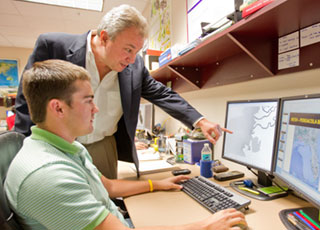
In FY15, NCCOS Ecological Effects of Sea Level Rise (EESLR) program funded research to assess the vulnerabilities of coastal communities and ecosystems to sea level rise, coastal erosion, and severe storms. This research improved two models and initiated three partnerships to apply improved models in land planning and flood preparedness efforts in Central Florida, Virginia and the Northeast region of the U.S.These models illustrate the need to incorporate sea level rise, storm surge, and landscape change in future assessments of coastal infrastructure.
NCCOS also awarded $1.2M for coastal resilience research in FY15, including a socioeconomic analysis of the benefits of natural infrastructure, modeling the ability of marshes to attenuate high tides and storm surge in North Carolina, beach and dune modeling in North Carolina, advancing marsh modeling in San Francisco Bay, and improved modeling to guide conservation planning along the coast of Hawai'i.
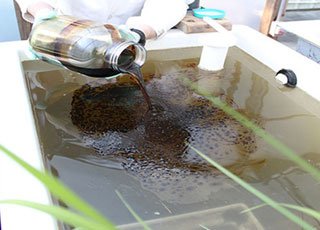
NCCOS continues to support the Natural Resource Damage Assessment (NRDA) of the Deep Water Horizon (DWH) oil spill by quantifying the spill's impacts to bottlenose dolphins, benthic organisms and sediment quality, and is improving NOAA's oil spill mitigation capabilities by examining the effects of oil dispersants on estuarine animals.
In FY15, NCCOS scientists reported that persistent organic pollutants were likely not a contributing factor to the poor health and increased mortality seen in some populations of bottlenose dolphins following the oil spill. NCCOS worked with other NOAA offices to develop guidelines for assessing injury to marine mammals from oil spills. These studies documented spill-related effects on benthic invertebrate communities and sediment quality in the vicinity of the DWH wellhead, which included a decline in the condition of soft corals. Results of these studies are supporting the development of a Damage Assessment and Recovery Plan (DARP) as part of the ongoing DWH NRDA process.
Additionally in 2015, using a simulated saltmarsh, NCCOS determined dispersant and dispersed oil toxicity thresholds in six estuarine species. Results are being used to predict the impacts of dispersants, to support recovery assessments, and to support decisions on dispersant use in future oil spill events.
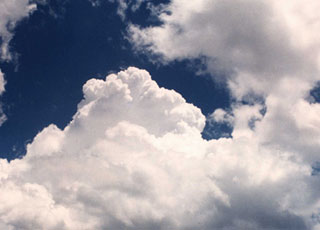
Building upon Lessons Learned from the NOS Sandy Work Integration Group and Sandy Supplemental funding experience, NOS brought together representatives from all program offices to collaborate on an integrated, compelling story of what NOAA can do with supplemental resources to enhance our delivery of Resilience products and services. A plan was created that includes justification of our enhanced capabilities should the need for emergency action arise. This guiding document can be scalable for any event & related supplemental possibility that may go along with it.
From this, NOS provided significant support and guidance for the development of a NOAA Blue Skies Plan - a cross-Line/Staff Office collaboration to enhance NOAA's delivery of products and services aimed at helping communities recover from natural disasters, and to predict and be more resilient and prepared for the next event. The purpose of the blue sky planning exercise was to develop integrated strategies for NOAA to use as a starting point when emergency supplemental capabilities are needed.
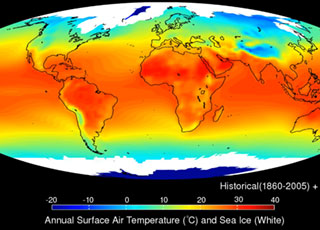
A series of five regional workshops for more than 400 formal and informal educators was sponsored by NOAA's Planet Stewards Education Project, led by NOS CED. This effort supports OSTP's Climate Education, Literacy and Training initiative announced in December. The workshops were developed with Federal, State, and NGO partners in Chicago, IL; Seattle, WA; St. Petersburg, FL; Boulder, CO; and Silver Spring, MD.
Each workshop focused on regional and/or topical impacts of climate change to connect educators and their audiences to the best-available, science-based information and resources about climate change. Attendees interacted with climate science, education and communication experts, participated in hands-on education activities and explored innovations in Earth-system research. Post workshop evaluations showed that attendees were significantly more knowledgeable in workshop content, and all planned to address the topics presented in the workshops within the next year by sharing the information and resources with over 10,000 people including their colleagues, youth and adults in formal and informal education settings.
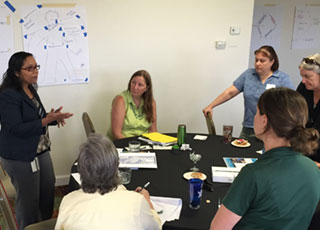
More than 1,200 formal and informal educators, federal, state and NGO employees attended live monthly broadcasts of nationally recognized scientists, educators, and communicators organized and facilitated by the NOAA Planet Stewards Education Project (PSEP). Archives of the webinars were viewed and downloaded by hundreds more. This effort is part of PSEP's ongoing commitment to provide sustained professional development and support in building a science and climate literate public by offering the most current data and information representing NOAA and NOS activities and priorities to a broad national audience. Post event evaluations indicated that on average, 95% of webinar attendees learned from the presentations and 86% of webinar attendees intended to use what they learned from the presentations in their work over the next 12 months. Presentations included: Ice-Core Records of Global Warming and Abrupt Climate Change; Crucial facts regarding man-made climate change; NOAA's Sentinel Site Program: Engaging Communities for Coastal Resilience; Western Water Resources, Climate and Science; Traditional Environmental Knowledge and Climate Change Impacts on Indigenous Peoples; Climate Science, the President's Climate Action Plan, and Citizen Science; Climate and Ecological Forecasting: Predicting and Preventing Health Risks.

Protecting NOS's IT-related services against the constant threat presented by computer viruses, phishing attacks, and hackers is critical to meeting the agency's mission. To make that happen, NOS continuously assesses weaknesses and creates Plans of Action and Milestones, known as POA&Ms, to address them. Each POA&M is an improvement plan with the goal of enhancing the agency's cybersecurity posture. NOS successfully closed 230 separate POA&Ms in FY15.
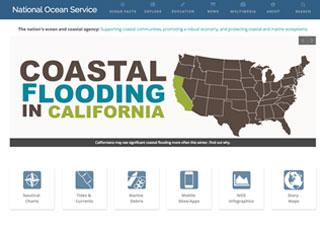
NOS uses its online presence to reach the ocean-interested public. Traffic to the NOS website increased 25.5% during FY 2015 compared to FY 2014. The number of Facebook "likes" grew more than 20% (from 52,640 to 64,413) and the number of Twitter followers grew more than 25% (from 101,807 to 129,480). During its 30-day National Ocean Month campaign, NOS reached more than 1 million users on Facebook. NOS continues to explore new platforms to reach a greater audience. In March, NOS completed its first Reddit Ask Us Anything with two scientists on an expedition in the Caribbean aboard the NOAA Ship Nancy Foster. The session generated more than 200 questions and was upvoted 89% of the time. In June, NOS launched a presence on Instagram, which is growing steadily.
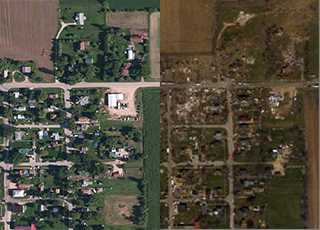
FY15 is the first year the National Geodetic Survey (NGS) has collected aerial oblique imagery prior to disastrous events (i.e. hurricanes, tornadoes, oil spills, etc.). This provides two major benefits: it covers the shoreward-facing side of structures and other infrastructure not visible with traditional aerial photography, and it allows us to photograph coastal damage much more quickly than traditional methods. In a natural disaster, emergency responders can compare georeferenced oblique imagery from before and after the event to help them make time-critical decisions for response and recovery efforts.
NGS collected aerial imagery following two major natural disasters in FY15. In January, NGS collected aerial damage assessment imagery in the aftermath of the Nor'easter that blanketed the region in snow and caused significant storm surge along the New England coast. The following April, more than 2,800 images were collected in areas most impacted by multiple tornado strikes in Northern Illinois to support Illinois’ Tornado Emergency. Aerial imagery provides a cost-effective way to better understand the damage sustained to both property and the environment and is a crucial tool used by federal, state, and local officials and the public.
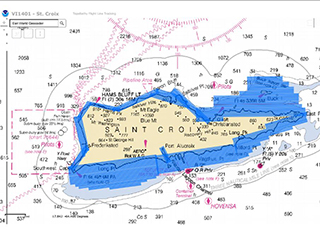
The National Geodetic Survey (NGS) completed a three-week project in St. Croix, U.S. Virgin Islands to collect airborne topographic-bathymetric (“topo-bathy”) light detection and ranging (lidar) data and imagery of the shoreline, using the NOAA Twin Otter aircraft. The survey supports data requirements for both NOS’s Office of Coast Survey (OCS) and the National Centers for Coastal Ocean Science (NCCOS) and will help update charted depths for most of the island. The last survey of the island was acquired via single-beam sonar in 1980.
Topo-bathy lidar acquires land values—or heights—and depths under the water surface. It is used to supplement hydrographic survey data for updating NOAA Nautical Charts and to enable NCCOS to create habitat maps.
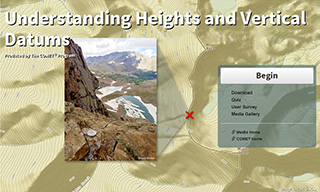
In a FY15 collaborative effort between the National Geodetic Survey (NGS) and The COMET® Program, the first in a series of training lessons for scientists, engineers, and mapping professionals was developed and released. The lesson provides a basic understanding of vertical datums and how to choose the appropriate datum for a given application. A conceptual understanding of ellipsoidal, geopotential, and tidal datums was also introduced.
Accurate heights are vital for emergency preparedness, floodplain mapping, restoration, urban planning, and more. This training lesson represents NGS’s commitment to engaging and educating its customers for a successful transition to the new vertical datums NGS plans to release in 2022. This interactive presentation provides participants with knowledge to better understand the impact of the new datums. NGS has received positive feedback and plans to add to its educational library.
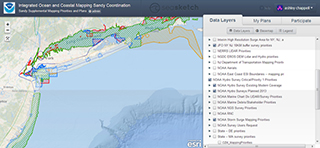
To improve coordination of data acquisition in U.S. waters, NOAA's Integrated Ocean and Coastal Mapping Program (IOCM) expanded the scope of its ocean and coastal mapping SeaSketch site. The site also includes information on topographic data acquisition plans generated by the 3D Elevation Program, a terrestrial-focused working group that complements the Interagency Working Group on Ocean and Coastal Mapping. The U.S. federal mapping coordination site now displays federal and state mapping requirements, plans, and priority areas of many partners on various levels, which will improve decision making throughout all levels of government.
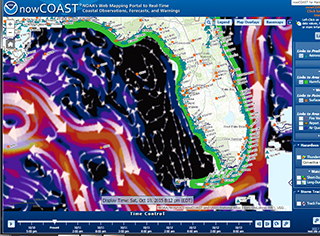
NOAA's Office of Coast Survey released a new version of nowCOAST, a GIS-based online mapping portal that provides near-real-time observations and forecasts for coastal and marine weather, and oceanographic and hydrologic conditions. The new version provides more frequent updates. It also offers a visual point-and-click access to 60 NOAA data products and services, such as the latest National Weather Service watches, warnings, and advisories for hazardous conditions; GOES water vapor imagery; model forecast guidance from additional NOS oceanographic forecast systems; higher temporal resolution of weather and marine forecasts; and satellite-emulated lightning strike density. For advanced users, the new version now provides access to nowCOAST's map layers via time-enabled REST and Web Map Services.
Coast Survey implemented this new nowCOAST version in collaboration with the National Weather Service GIS hosting facility in College Park, Maryland. This implementation ensures availability of nowCOAST's map viewer and map services 24 hours a day, 7 days a week for emergency management, homeland security, search and rescue, HAZMAT response, and marine operations.
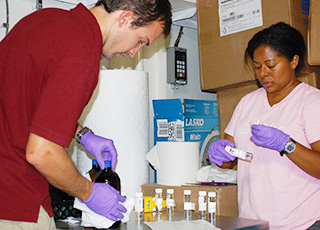
A flexible new data management tool known as DIVER was developed by NOAA to support the Natural Resource Damage Assessment for the 2010 Deepwater Horizon oil spill. DIVER stands for "Data Integration, Visualization, Exploration and Reporting," and provides unprecedented flexibility for filtering and downloading validated data collected as part of the damage assessment efforts for the Gulf of Mexico.
DIVER was developed as a digital data warehouse during the Deepwater Horizon oil spill response effort and related damage assessment process, which has required collecting and organizing massive amounts of scientific data on the environmental impacts of the spill.
The tool serves as a centralized data repository that integrates diverse environmental data sets collected from across the Gulf of Mexico ecosystem. It allows scientists from different organizations and laboratories located across the country to upload field data, analyses, photographs, and other key information related to their studies in a standardized format. DIVER thus brings together all of that validated information into a single, web-based tool.
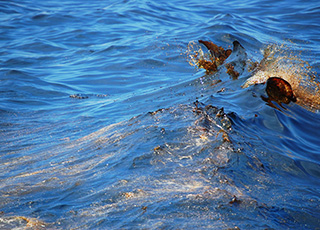
On July 2, 2015, BP reached an agreement in principle with the United States and the five Gulf states to settle the civil claims against the company arising out of the Deepwater Horizon oil spill tragedy. Although the terms are not final or binding until a consent decree is negotiated, undergoes public comment, and secures court approval, BP has announced the value of the settlement to be approximately $20.8 billion. Of this proposed settlement up to $8.8 billion will go to natural resource damages and fund Gulf restoration projects as designated by the trustees.
The agreement in principle led to the October 2015 release of the draft comprehensive restoration plan for the Gulf of Mexico. The draft plan would allocate funds to meet five restoration goals and 13 restoration types designed to meet these goals. Together, these efforts will restore wildlife and habitat and increase recreational opportunities in the Gulf.
Scientific data for the Deepwater Horizon oil spill can be accessed on the public data warehouse and query tool DIVERExplorer, as well as our online mapping tool ERMA®Deepwater Gulf Response.
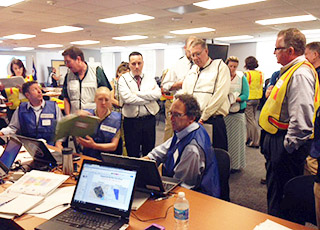
The National Ocean Service enhanced its response and recovery posture for future all-hazards events in a major drill involving more than 60 staff and coordinated by NOAA’s Office of Response and Restoration and NOAA’s Homeland Security Program Office.
Code named "The Little Splash," this training event exercised NOS’ capability to establish incident coordination as described in the 2014 updated Concept of Operation (CONOPS) Plan. The event simulated a response to a small tsunami wave impacting the East Coast, which resulted from a major landslide in the Canary Islands off Africa. Through the exercise which was carried out in Silver Spring, MD, Chesapeake, VA, and Charleston, SC, NOAA staff, facilities, and missions were challenged to respond to the drill as though it were a real emergency, providing a consistent visualization for everyone involved. Among the activities, field staff provided real-time situational reports to the NOS Incident Management Team about impacts and response activities, Environmental Response Management Application (ERMA®) served as the common operational picture, and NOAA’s communications team simulated a press conference.
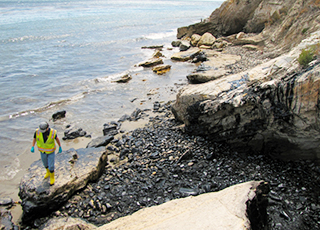
In May of 2015, a 24-inch pipeline rupture released approximately 100,000 gallons of crude oil near Refugio State Beach in Santa Barbara County, California, with a reported 21,000 gallons flowed into the Pacific Ocean.
NOAA’s Office of Response and Restoration provided overflight observation of the spill, information on fate and effects of the crude oil, potential environmental impacts both in the water and on the shore, and observational and data management support for the Natural Resource Damage Assessment. The spill closed down multiple beaches and fisheries and caused harm to birds, marine mammals, fish, and marine invertebrates. NOAA and our state and federal partners are investigating these impacts.
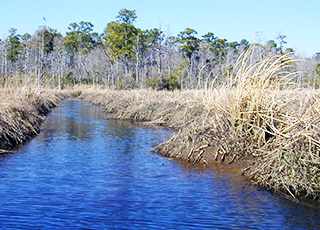
NOAA, U.S. Fish and Wildlife Service, and the State of North Carolina will receive more than $22 million for natural resource damages from the Kerr-McGee Superfund site in Navassa, North Carolina.
The settlement was part of a larger $5.15 billion Department of Justice settlement with Anadarko Petroleum Corporation. Damages to natural resources were the result of creosote-wood treating that took place on the site from the 1930s until the mid-1970s. Polycyclic aromatic hydrocarbons (PAHs) from the wood treating have been found at elevated levels in on-site soils, groundwater, and Sturgeon Creek sediments.
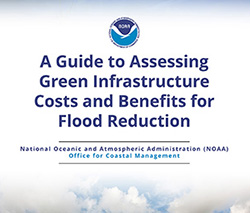
NOAA’s Office for Coastal Management has developed three new green infrastructure products are helping coastal communities use natural and nature-based systems to absorb and filter excess water and reduce flooding. These new offerings include an interactive animation that illustrates how green infrastructure can help protect communities from storm impacts; a guide for spatial analysts who want to incorporate green infrastructure into mapping efforts; and a cost-benefits process that people are using to determine what green infrastructure strategies make the most sense for their community. These additions join other products featured on the green infrastructure section of the Digital Coast website.
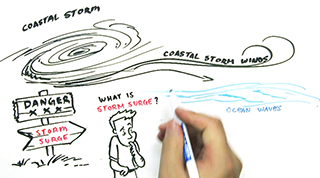
Using eye-catching graphics, the new Storm Surge Fast Draw (also available in Spanish) animation explains the dangers that storm surge can pose to people and their property. Social science research indicates residents in coastal areas many miles inland might not realize they live in a storm surge-affected area and might not leave if an evacuation is issued. With storm surge posing a year-round threat, this fast-draw video (also availablecan be used for outreach during tropical or winter storm season to help people understand when preparation and evacuation is critical. The video was created by the Office for Coastal Management in collaboration with the National Weather Service.
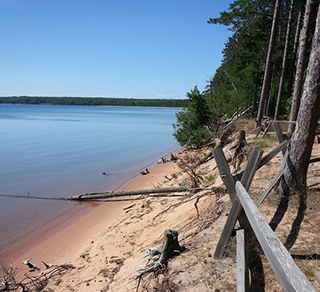
Fluctuating levels in the U.S. Great Lakes are resulting in renewed community interest in topics such as encouraging sustainability, planning for infrastructure, conserving habitat, and zoning restrictions. Helpful in these discussions is a new NOAA tool developed for this purpose, the Lake Level Viewer. This tool portrays the impacts of lake level change on coastal areas and resources. Tool users download the data and access services within the tool for more in-depth analysis. This easy-to-use tool was designed and tested with input from Great Lakes stakeholders. It was selected as a Site of the Month by the Great Lakes information Network, which averages 4.5 million monthly hits. Designed by the Office for Coastal Management and funded by President Obama’s Great Lakes Restoration Initiative, the viewer complements the Great Lakes Environmental Research Lab’s Water Level Dashboard.
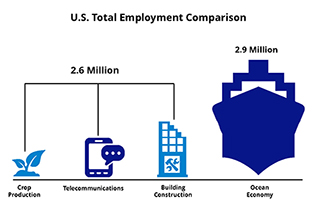
Understanding the value of the ocean is a crucial component of community decision making, yet the economic data we need are not always readily available or easy to understand. NOAA’s ENOW (Economics: National Ocean Watch) data were developed in response to this need. A 2012 fact pulled from the website, for instance, says the U.S. ocean and Great Lakes economy grew by 10.5 percent in real gross domestic product (GDP)—more than four times as fast as the U.S. economy as a whole. More facts, as well as the latest data and trends, soon will be online in the NOAA Report on the U.S. Ocean and Great Lakes Economy. These and other economic-centered products are available from NOAA’s Digital Coast, which is provided by the NOAA Office for Coastal Management.
During the past year more than 10,000 acres of coastal lands were acquired or designated for long-term protection through the Coastal Zone Management Program. State partners executed these actions, in many cases by creating a conservation easement. These same programs also constructed or enhanced 385 public access points. Giving people access to the nation's natural resources is an important and popular part of the local and national coastal management effort.

NOAA scientists continue to deliver products and tools to help resource managers predict and prepare for the ongoing and destructive global coral bleaching event. In early 2015, based on data from satellites and climate models, NOAA scientists sounded the alarm that corals in the Pacific and other regions were at risk for bleaching. Months later, more warnings followed for coral reefs in much of the Northern Hemisphere, which prompted NOAA to declare the onset of the third recorded global coral bleaching event. In addition to forecasting thermal stress events and bringing them to worldwide attention through the media, the NOAA Coral Reef Conservation Program released its strategy to reduce the impact of climate change and ocean acidification to coral reefs, as well as a list of the top 10 things resource managers can do to prepare and respond to bleaching events. Researchers also contributed to a study that projects the impacts of climate change on the world's oceans and the goods and services they provide. NOAA has identified climate change as a key global threat to coral reef ecosystems. The Coral Program works across federal agencies and with local, regional, and international partners to coordinate efforts to address the impacts of climate changes and foster more resilient coral reefs.
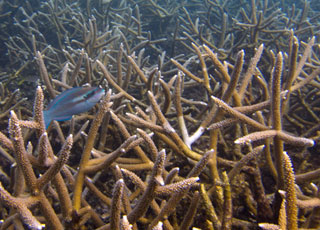
Florida's Biscayne Bay and Puerto Rico's Northeast Marine Corridor and Culebra Island have been named as NOAA Habitat Focus Areas—places where the agency can maximize its habitat conservation investments and management efforts to benefit marine resources and coastal communities. Biscayne Bay is threatened by harmful algal blooms, and an investigation of water quality conditions that promote these blooms is needed to reduce nutrient inputs where possible. The Northeast Marine Corridor and Culebra Island are home to a diversity of coral reef species, mangroves, seagrass beds, and other habitat types. NOAA's Coral Reef Conservation Program is actively working with teams across NOAA line offices and partners in Puerto Rico to develop a strategy to address the top threats to the region's unique habitats. The recognition of Biscayne Bay and the Northeast Marine Corridor and Culebra Island as Habitat Focus Areas under NOAA's Habitat Blueprint allows the agency to maximize its habitat conservation efforts in these areas. The Coral Reef Conservation Program is leading much of NOAA's efforts to support ridge-to-reef science and place-based conservation in both areas, and Puerto Rico in particular.
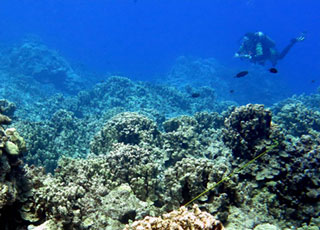
NOAA scientists and partners in the Commonwealth of the Northern Mariana Islands developed innovative techniques to evaluate coral reef resilience. An assessment of 78 coral reef sites off Saipan, Tinian, Aguijan, and Rota revealed that Saipan, the most populated island, is home to the most resilient reef sites in the study. Sites off Rota, the most isolated island, ranked low in terms of resilience. Study findings were used to identify priority sites for six types of management actions including: conservation, land-based sources of pollution reduction, and fishery management and enforcement. The data also indicate that the presence of herbivores, coral recruitment and the exchange of coral and fish larvae between islands are key drivers of resilience. Reefs in the commonwealth experienced widespread bleaching in 2013 and 2014, but were spared during the 2015 global bleaching event. The assessment results supported by the NOAA Coral Reef Conservation Program provide an innovative tool to help officials implement effective resilience-based management strategies. The methodology has global relevance as efforts move increasingly toward managing for resilience. The commonwealth is home to diverse coral reef ecosystems that provide residents with many goods and services. This approach to evaluating reef resilience will provide much-needed guidance on where and what type of conservation actions will ensure the commonwealth has healthy reefs in the future.
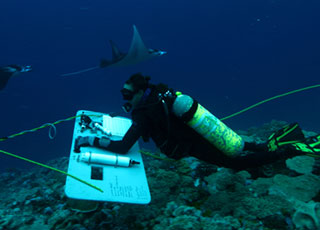
Scientists continued to collect biological, climatic, and socioeconomic data to measure changes in U.S. coral reef ecosystems as part of the National Coral Reef Monitoring Program. In the U.S. Pacific Islands of American Samoa and the U.S. Pacific Remote Islands Marine National Monument, NOAA scientists conducted hundreds of fish and benthic surveys and recovered and re-deployed instruments to assess impacts of ocean acidification and warming. In the Atlantic, experts gathered similar data at sites in the U.S. Virgin Islands and the Flower Garden Banks. Social science researchers focused on the connections between coral reef ecosystems and the people, their communities and economies by completing resident surveys in Hawaii and Puerto Rico. Teams established climate data collection sites in the Gulf of Mexico and the Atlantic and Pacific Oceans to support modeling efforts and to identify areas of reef resilience and vulnerability. Satellite remote sensing provided data across all U.S. reef areas, filling gaps between filed sampling sites. The National Coral Reef Monitoring Program is an integrated and focused monitoring effort with partners across the U.S. and its territories. Outcomes will help managers, decision makers, and communities better understand the condition of their resources and take effective place-based conservation actions. This effort is supported by the NOAA Coral Reef Conservation Program.
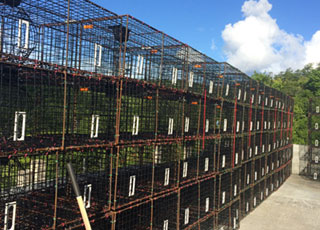
Fish traps are an economically important tool for local fishers in the U.S Virgin Islands, but they are generally considered a non-selective gear with high bycatch. Scientists and fishers cooperatively designed a more selective and efficient fish trap that reduces bycatch. NOAA and the St. Thomas Fishermen's Association partnered to conduct a series of experiments resulting in a final vent design that successfully maintained or improved catch rates while reducing capture of non-target and undersized species. This includes herbivorous species that, by grazing algae on the reef, play an important role in maintaining ecosystem balance and resilience. The unwanted fish escaped underwater before the traps were hauled to the boat, so the fishers spent less time handling unwanted fish before resetting their traps. Fishers across St. Thomas are adopting the new design and sharing results with neighboring fishing communities. This work, funded by the NOAA Coral Reef Conservation Program and others, demonstrates the effectiveness of scientists and fishers working together to come up with real-world solutions to fisheries challenges.

Fish traps are an economically important tool for local fishers in the U.S Virgin Islands, but they are generally considered a non-selective gear with high bycatch. Scientists and fishers cooperatively designed a more selective and efficient fish trap that reduces bycatch. NOAA and the St. Thomas Fishermen's Association partnered to conduct a series of experiments resulting in a final vent design that successfully maintained or improved catch rates while reducing capture of non-target and undersized species. The unwanted fish escaped underwater before the traps were hauled to the boat, so the fishers spent less time handling unwanted fish before resetting their traps. Fishers across St. Thomas are adopting the new design and results will be shared with neighboring fishing communities. Their work, funded by the NOAA Coral Reef Conservation Program and others, demonstrates the effectiveness of scientists and fishers working together to come up with real-world solutions to fisheries challenges.
 An official website of the United States government.
Here's how you know we're official.
An official website of the United States government.
Here's how you know we're official.
































